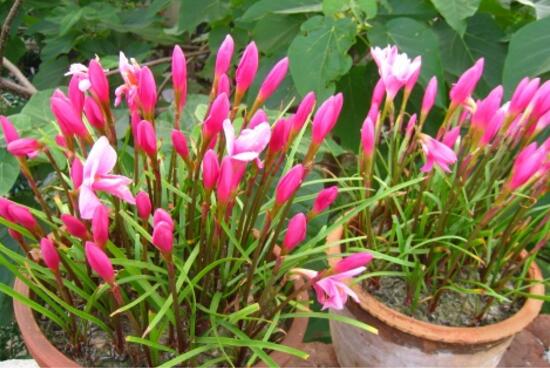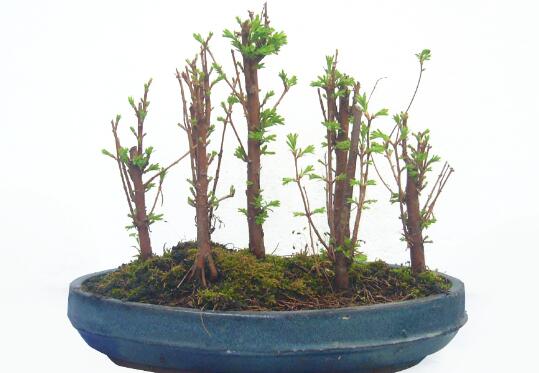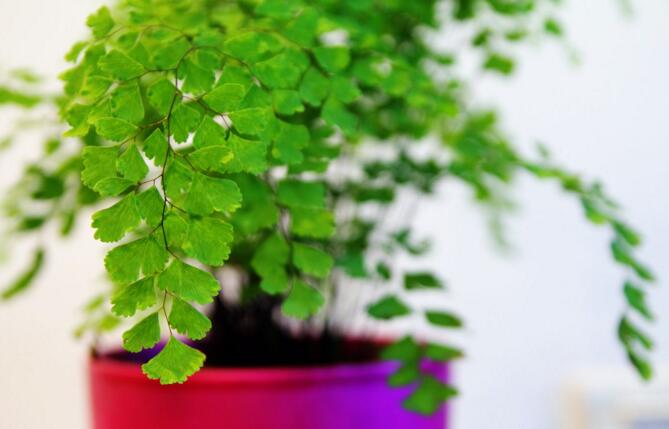How to propagate Chinese chive lotus, the method of propagation (dividing ball / ramet / sowing)
The flower friends who have seen the leek lotus should be impressed. The green leaves, accompanied by pink flowers, are particularly beautiful at home. In life, many people raise a pot of leek lotus at home. Some of them buy existing potted plants directly, while others breed by themselves. How do they breed leek lotus? The following are three breeding methods of leek lotus, follow the editor to learn about it.
1. How to reproduce, divide balls / ramets / sow seeds

As a common indoor breeding product, the breeding method of leek lotus can be said to be very simple, but it is not easy to breed it yourself. Each kind of plant has its own method of reproduction, and there are generally three ways to reproduce leek lotus: dividing balls, dividing plants and sowing seeds.
2. Three propagation methods of leek lotus
The propagation methods of leek lotus include bulb ramet, bulb ramet and sowing. The bulb division method is to dig out the bulb root and separate it from the mother and cultivate it in the soil; the bulb ramet is to dig out the underground bulb in the basin, remove the old soil and put it in the new culture soil; sowing is to sow the leek lotus seeds in autumn, and then let's take a look at the specific operation.
(1) Propagation of leek lotus by ball-dividing method.
1. Time to divide the ball
The most common reproduction and release of leek lotus is to divide balls, and its best operation time is in spring and autumn. Pay attention to ensure adequate light, fertilizer and water in the process of breeding.
2. Ramet method
The bulb was dug out, separated from the mother, and then cultivated in the soil to become an independent new plant. After dividing the ball, pour water thoroughly, put it in a cool place, and you can see the sun a week later.
(2) bulb ramet propagation of leek lotus.
1. Ramet time
The time of ramet propagation is not fixed, and the plant time of not excessive plants is required, that is, leek lotus should grow for 2-3 years.
2. The method of dividing the ball
Dig out the underground bulbs in the basin, 3-5 leek lotus bulbs into a nest, and then get them out, get rid of the old soil. Place new culture soil in the flowerpot and finally plant the leek lotus bulb in it. Note: if you want to continue to separate planting in the future, you can choose deep planting, the soil is about three centimeters higher than the bulb.
(3) sowing and propagation of leek lotus
The seeds of leek will mature about 20 days after the lotus blossom stage, which is usually in the middle and late September. We will collect the seeds immediately after sowing, and cover 1 cm thick matrix. After that, when the basin soil is slightly dry, it will be watered again, but the watering force should not be too strong, so as not to rush the seeds.
Generally speaking, the breeding of leek lotus, whether it is dividing balls, ramets or sowing, can survive, but if it is said that it is most suitable for flower friends, the highest survival rate is also divided balls. Of course, the method is dead, people are alive, we can according to the actual situation, choose the method to breed. With regard to the breeding method of leek lotus, the editor has introduced this, hoping to bring help to everyone.
The breeding method and pest control of Chinese chive orchid, the difference between it and onion orchid
Leek orchid is large in shape, pink, petals slightly curved; small leek orchid is thick peach red, adult each bulb can blossom, clump of flowers, brilliant in the sun, charming, loved by everyone. What is the breeding method of leek orchid? What are the methods of its diseases and insect pests? Come and learn from the editor.
Reproductive methods and pest control
It can be planted by split plant or bulb, which can be carried out all the year round, but it is the best in spring. As long as the root of the ball is dug up, 5 balls are planted in each place, and the watering is kept properly.
The humidity is very easy to survive. When digging up the bulbs, be careful not to hurt them. If there are too many leaves and flower stems, cut off the upper part and leave the complete bulb and 6Mel 8cm leaves for planting. If the bulb has germinated buds and fully watered after branching, it can still blossom. [6]
The seeds of Chinese chives usually mature from September to October. Because of its long flowering period, the time for seed collection is not concentrated. Pay attention to observe that when the pericarp changes from green to black, select full and full seeds to be harvested in time, otherwise the fruit will crack and it will not be easy to collect once it falls off. After the fruit is collected, it should be dried in time, and after the peel is cracked, it should be threshed in time, and the pure seeds can be obtained by removing sundries. Because the cold tolerance of Chinese chive is slightly poor, it should be sown in spring.
Preservation of seeds: as the seeds of leek orchid are relatively small and have low water content, after fully drying, the seeds to be processed can be stored in Kraft paper bags to prevent mildew and rot.
Diseases include leaf rust and spot disease; insect pests include grubs. Small leek orchid has strong resistance to diseases and insect pests. When the disease occurs, the whole plant can be sprayed with 1RU 3000 methyl topiramate, and the underground pests can use phoxim to irrigate the plant.
The difference between green onion orchid and leek orchid
(1) Leaf
Green onion orchid leaves are round, erect and not easy to bend or lodge; leek orchid leaves are flat, wider, easier to bend or lodge.
(2) flowers
The flowers of onion orchid are generally white, the flowers of leek orchid are usually pink, and the flowers of leek orchid are slightly larger than those of onion orchid.
Main categories
Amaryllidaceae, alias leek lotus (Beijing), saffron (Guangxi, Guizhou), daffodil, hollow leek (Guizhou), calamus lotus, red jade curtain, wind and rain flower (North China), red gladiolus lotus (Beijing), plant height is about 15-30 cm. The leaves are linear, very similar to leeks. The flower stem is extracted from the foliage and has 6 petals. The small leek orchid is thick pink, and each bulb can blossom as an adult. Originally from southern Mexico to Guatemala, gardens are introduced and cultivated in the north and south of our country, and are common in Guizhou, Guangxi and Yunnan.
Growth habit
Strong in nature, drought-resistant and high-temperature resistant, easy to cultivate, the suitable temperature for growth is 22-30 degrees, and the fertile sandy loam is the best cultivated soil. Leek orchid likes light, but it is also resistant to semi-overcast. Like a warm environment, but also more hardy. Loam or sandy loam with deep, flat terrain and good drainage. Like to be wet, afraid of flooding. Strong adaptability, strong resistance to diseases and insect pests, corm germination is also strong, easy to reproduce.
That's all I know about Jiulan today. I hope it will be helpful for you to read this article. If you want to know more about Jiulan, please continue to pay attention to the succulent flower bed, we will provide you with more related knowledge!
Planting methods and cultivation techniques of green onion orchid
Green onion orchid, also known as onion lotus, leek lotus, liver herb, etc., is a perennial herb of Lycoris family, native to South America, and now it is planted all over China, often used as the edge material of flower beds, and it is also suitable for green space cluster planting. It is most suitable to be used as a ground cover plant in the lower half-shade of the forest or planted beside the courtyard path. Let's take a look at the breeding methods and matters needing attention of onion orchid.
Growth habits of onion orchid
Green onion orchids like fertile soil, like sufficient sunshine, resistant to semi-shade and low humidity, and should be fertile, sticky and well-drained soil. It is hardy, it can keep evergreen in the Yangtze River basin, and it can survive for a long time below 0 ℃. Under the condition of about-10 ℃, it will not be frozen for a short time, but it may freeze to death for a long time. Green onion orchid is very easy to divide balls naturally, and it is easy to propagate, so it is necessary to pay attention to the proper protection against cold in winter.
Propagation methods of onion orchid
1. Ramet: the ramet of onion orchid is carried out after the soil is thawed in early spring, and the mother plant is taken out of the flowerpot, shaking off the excess potted soil, separating the root system as much as possible, and cutting it into two or more plants with a sharp knife. each plant should have a considerable root system, and its leaves should be pruned properly to facilitate survival.
2. Sowing: about 20 days after the onion orchid becomes hot, the seeds should be harvested in time, and the most suitable temperature for sowing is 15: 20 ℃. The seeds are often sown in autumn after mid-late September, and the seeds are glued to the surface of the substrate one by one, covering the substrate 1 cm thick. Later, when the basin soil is slightly dry, it will be watered again, but the watering strength should not be too strong, so as not to rush the seeds.
Culture method of onion orchid
1. Environment: choose places where the wind is sunny and the soil is fertile and moist. Keep the soil moist during the growth period. If yellow leaves and residual flowers are found during flowering, they should be cut off and removed in time to maintain beauty and avoid consuming more nutrients.
2. Potted soil: potted soil is very important. Cohesive soil, powdery soil and alkaline soil are not suitable to raise orchids, because these soils are not conducive to rooting, not easy to drain, and poor ventilation. Planting orchids with this kind of soil will form stiff seedlings with short roots of grass.
3. Watering: onion orchids should be watered adequately during the growth period, and it is appropriate to keep the basin soil moist, but not stagnant water. When the weather is dry, water is often sprayed on the leaves to increase air humidity, otherwise the leaf tips are easy to yellow and wither.
4. Fertilization: green onion orchid requires more fertilizer and water as other grass flowers, and it can grow well and bloom luxuriantly after topdressing 2 or 3 times a year. After fertilizing, keep the leaves and flowers dry at night.
5. Temperature: green onion orchids like a warm climate, but the hot and muggy environment in summer is not conducive to growth. The temperature in winter is very strict, and the growth stops when the ambient temperature is below 10 ℃, so it can not survive the winter safely when the frost occurs.
Points for attention of green onion orchid
1. Fertilizer application: onion orchid requires more fertilizer and water, but is most afraid of random fertilization, concentrated fertilizer and partial application of nitrogen, phosphorus and potash fertilizer. It is required to follow the principle of "frequent application of light fertilizer, less and more times, and complete nutrition".
2. Watering essentials: onion orchid should be well watered during the growing period, and the basin soil should be kept moist, but not stagnant water. When the weather is dry, water is often sprayed on the leaves to increase air humidity, otherwise the leaf tips are easy to yellow and wither.
3. Pot soil replacement: onion orchids are usually not specially turned into pots, but are replanted every year when combined with ramets. At the bottom of the basin, a thick matrix of 2 cm and 3 cm was placed as the filter layer, and then the plant was put in.
4. Pest control: onion orchid is mainly harmed by leaf withering disease, which is controlled by spraying 65% Daimen zinc wettable powder 600 times. Pests include Plutella xylostella and thrips, which can be sprayed with 2.5% deltamethrin EC 4000 times.
- Prev

How to propagate Metasequoia glyptostroboides, list of propagation methods / cutting propagation / sowing propagation
Metasequoia glyptostroboides is a highly ornamental plant, and there are many people who raise it in our country, but with more people raising it, people are more concerned about its reproduction, so how do metasequoia reproduce? What is the reproduction method of metasequoia? Next, the editor will take you to learn about it.
- Next

How does Dryopteris reproduce? can Dryopteris be cut / not cut / commonly used ramets?
Dryopteris is a fast-growing plant, so it is relatively easy to burst pots, and when raised for a period of time, flower friends need to consider the problem of reproduction, and can Dryopteris can be cut? How does Dryopteris reproduce? Next, the editor will introduce to you several common breeding methods of Dryopteris.
Related
- Fuxing push coffee new agricultural production and marketing class: lack of small-scale processing plants
- Jujube rice field leisure farm deep ploughing Yilan for five years to create a space for organic food and play
- Nongyu Farm-A trial of organic papaya for brave women with advanced technology
- Four points for attention in the prevention and control of diseases and insect pests of edible fungi
- How to add nutrient solution to Edible Fungi
- Is there any good way to control edible fungus mites?
- Open Inoculation Technology of Edible Fungi
- Is there any clever way to use fertilizer for edible fungus in winter?
- What agents are used to kill the pathogens of edible fungi in the mushroom shed?
- Rapid drying of Edible Fungi

